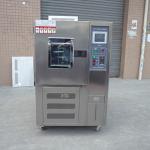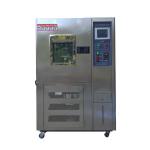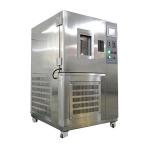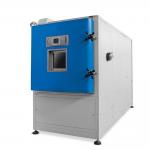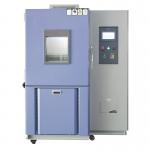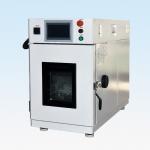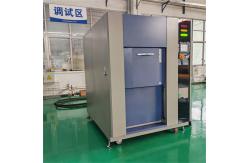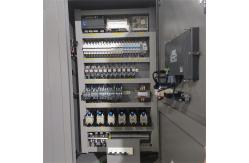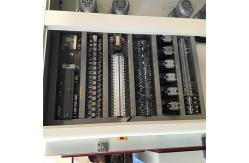In the fast-paced and highly competitive electronics industry, the
performance and durability of electronic components and devices are
non-negotiable. The Customized Environmental Climatic Chamber for
the Electronics Industry emerges as a crucial tool, meticulously
engineered to subject electronics to a gamut of environmental
stressors, thereby validating their robustness and functionality
under diverse conditions. This bespoke chamber is dedicated to replicating the complex and
often extreme environmental scenarios that electronics encounter
during their lifecycle. It serves electronics manufacturers,
research institutions, and quality control laboratories. The
overarching objective is to evaluate how electronic products,
ranging from minuscule microchips to elaborate circuit boards and
complete consumer electronics, perform and endure in the face of
temperature fluctuations, humidity levels, altitude changes, and
even exposure to corrosive substances and electromagnetic
interference. By doing so, manufacturers can preemptively identify
potential weaknesses, optimize designs, and enhance the overall
reliability and longevity of their electronic offerings. - Compact yet High-Performance Design
- The chamber is constructed with a space-efficient yet robust
framework, typically made of lightweight yet durable alloy
materials. The exterior is designed to be sleek and unobtrusive,
suitable for integration into modern electronics manufacturing and
testing facilities. The interior is crafted with an electrostatic
dissipative lining to safeguard against electrostatic discharge
(ESD) that could potentially damage sensitive electronic
components. The door is engineered with a precision sealing
mechanism, incorporating a conductive gasket and a secure locking
system, ensuring an ESD-safe and hermetic enclosure. A small but
highly durable viewing window, made of anti-static and anti-glare
glass, allows for visual inspection of the testing process without
compromising the chamber's environmental integrity.
- Precision Environmental Control Systems
- Temperature Control: Capable of maintaining a wide temperature
range, from -60°C to +150°C, with an outstanding accuracy of
±0.3°C. It employs advanced thermoelectric cooling and heating
technologies, which offer rapid temperature transitions and
excellent temperature uniformity. The control system is equipped
with a high-resolution feedback loop, featuring multiple
temperature sensors strategically placed within the chamber to
ensure minimal temperature gradients. The user-friendly control
panel permits the programming of intricate temperature profiles,
including rapid temperature ramps, extended soak times at specific
temperatures, and cyclic temperature sequences, all of which are
essential for mimicking real-world temperature variations such as
those experienced during device operation, transportation, and
storage.
- Humidity Control: The humidity control system is equally precise,
capable of achieving humidity levels from 5% to 95% RH (Relative
Humidity), with an accuracy of ±2% RH. It utilizes a combination of
ultrasonic humidifiers and desiccant dehumidifiers, integrated with
a carefully designed laminar air flow system. This ensures uniform
humidity distribution and rapid humidity adjustments. The chamber
is outfitted with highly accurate capacitive humidity sensors that
continuously monitor the internal humidity, and the control system
makes real-time adjustments to maintain the desired humidity
levels. This is crucial for testing the effects of moisture on
electronic components, such as the potential for corrosion,
short-circuiting, or degradation of electrical properties.
- Altitude and Pressure Simulation: To assess the performance of
electronics at different altitudes, the chamber can simulate
pressures ranging from vacuum levels up to several atmospheres,
with an accuracy of ±0.05 kPa. This is achieved through a
high-precision pressure control system that can precisely adjust
the internal pressure. By simulating altitude changes,
manufacturers can evaluate how components like semiconductor
devices, connectors, and displays behave in low-pressure or
high-altitude environments, where issues such as outgassing,
dielectric breakdown, or mechanical stress due to pressure
differentials may arise.
- Corrosive Substance and Chemical Exposure: The chamber can be
customized to introduce specific corrosive gases or chemical
vapors, such as sulfur dioxide, hydrogen sulfide, or salt mist, in
controlled concentrations. It is equipped with a gas injection and
mixing system that allows for precise dosing and uniform dispersion
of the corrosive substances. This enables the evaluation of how
electronic components resist chemical corrosion, which is vital for
products destined for industrial, marine, or chemically harsh
environments. The chamber also has a built-in exhaust and
purification system to safely remove the corrosive gases after
testing.
- Electromagnetic Interference (EMI) and Compatibility Testing: To
address the increasing concern of EMI in the electronics industry,
the chamber is designed to conduct comprehensive EMI and
compatibility testing. It is equipped with signal generators,
antennas, and spectrum analyzers to create and measure
electromagnetic fields. This allows for the assessment of how
electronic devices perform in the presence of external EMI sources,
such as radio transmissions, cell phone signals, or other nearby
electronic equipment. It can also test the emissions generated by
the tested devices to ensure they do not interfere with other
electronics. The chamber can be configured to meet various
international EMI standards, such as CISPR 25 and FCC Part 15,
providing a reliable platform for ensuring electromagnetic
compatibility.
- Advanced Instrumentation and Data Acquisition
|
